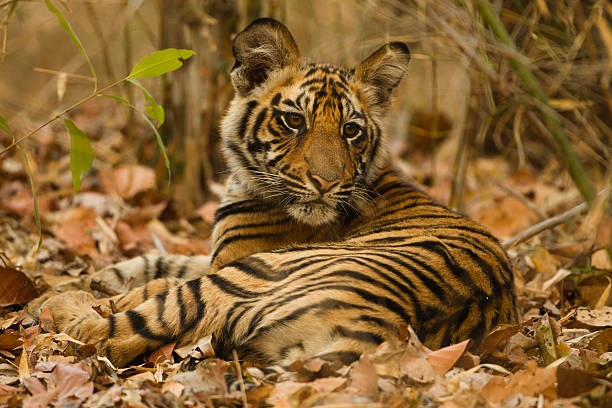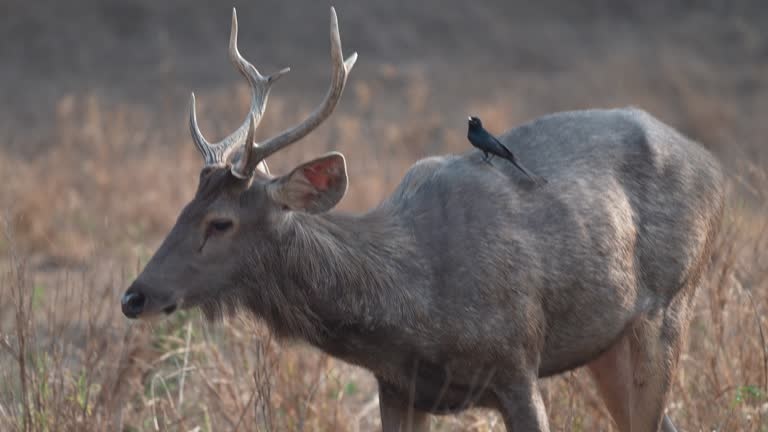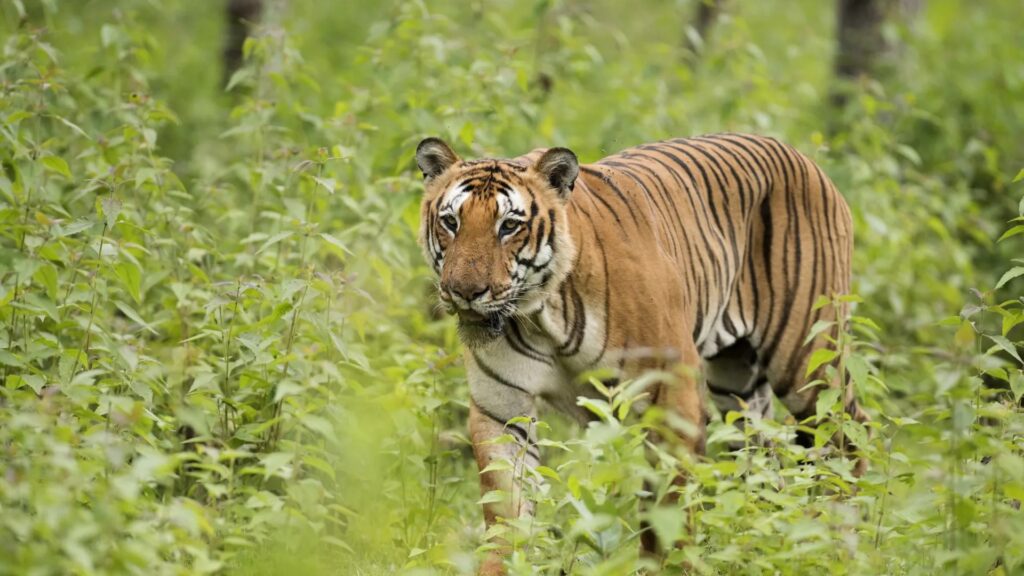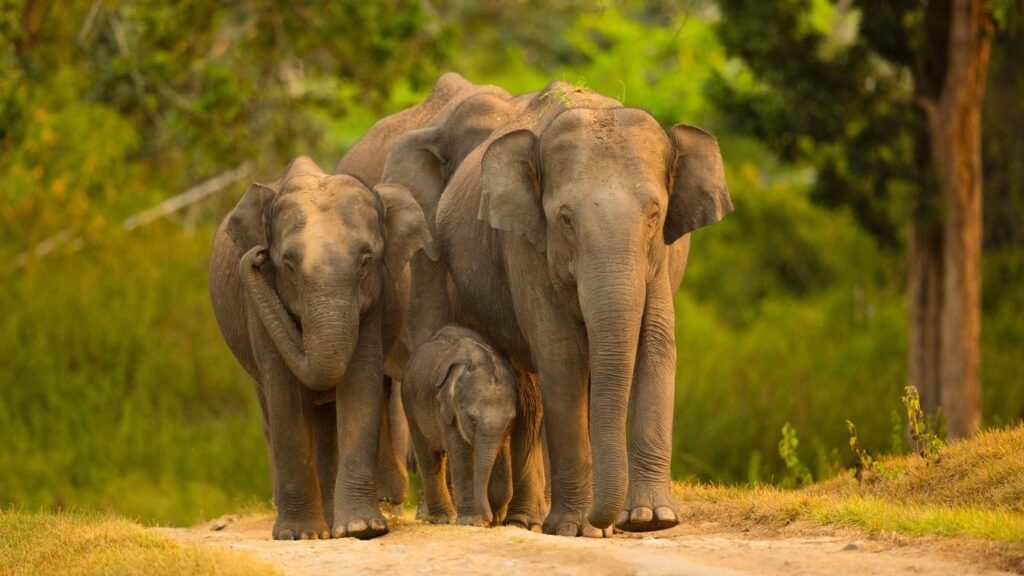Looking for an unforgettable adventure in 2025? Tiger safaris in India are an exceptional experience for all lovers of nature and majestic felines. With a huge population of tigers, India is an ideal country to see these magnificent creatures in their natural habitat. Renowned parks such as Bandhavgarh, Ranthambore, Kanha, Jim Corbett, and Panna offer unique opportunities to see tigers and discover rich biodiversity. Get ready to explore breathtaking landscapes and capture memorable moments on your next safari in India.

Tiger reserves in India play a vital role not only in tiger conservation but also in preserving the overall ecosystem.. They also offer unique experiences for visitors, combining adventure and wildlife discovery.
Tiger conservation in India is essential to maintaining ecological balance. With approximately 75% of the world’s tiger population, India is at the heart of conservation efforts. Tiger reserves such as Bandhavgarh National Park and Ranthambore National Park are emblematic examples of these successful initiatives. These reserves help to:
Conservation efforts have led to a significant increase in the tiger population in India, despite a dramatic decline of 95% from their historic global population.

Visiting a tiger reserve in India is like entering a wild and fascinating world. Each national park offers unique experiences: Bandhavgarh National Park: Located in Madhya Pradesh, this park is known for its tiger density, the highest in India. Safaris provide an exceptional opportunity to observe these majestic felines in their natural habitat, especially between April and June.
The most famous tiger reserve, Ranthambore National Park, is located in Rajasthan, in northern India. With its rich history and diverse wildlife, it offers an enriching experience, particularly between October and March. Kanha National Park: This park, also in Madhya Pradesh, inspired Rudyard Kipling’s famous “Jungle Book.” Its open grasslands and dense forests provide a magnificent setting for safaris, especially during the winter season. Jim Corbett National Park: This park is home to an impressive variety of wildlife. Located in the foothills of the Himalayas in Uttarakhand.
The eastern zone, particularly Bijrani, is particularly suitable for tiger watching. Panna National Park: This park, consisting primarily of open forests, offers numerous opportunities to observe tigers and other mammals. The diverse habitats, ranging from tall grasslands to closed forests, make it a prime destination from October to June.
These reserves not only protect tigers
But also provide opportunities for education, awareness, and sustainable tourism, contributing to a better understanding and appreciation of wildlife.

Located in Madhya Pradesh, near the Vindhya Hills, Bandhavgarh National Park is renowned for having the highest tiger density in India. This park is a true paradise for safari enthusiasts, and the chances of spotting tigers are particularly high.
Local guides are highly experienced and knowledgeable about tiger habits, increasing your chances of spotting them. In addition, the park’s natural beauty, with its hills, grasslands, and dense forests, makes every visit memorable.
Ranthambore National Park is located in Rajasthan, which is one of the most renowned tiger reserves in India. Not only is this park rich in tigers, but it also boasts a fascinating history and impressive biodiversity.
This park offers an excellent opportunity to observe tigers in a historic setting, with ruins of forts and temples scattered throughout the forest. Safaris in Ranthambore are very popular, so it is advisable to book well in advance to guarantee your spot.

The oldest national park in India is Jim Corbett National Park, located in the foothills of the Himalayas in Uttarakhand, this park offers an incredible diversity of flora and fauna.
In addition to tigers, you can see bears, gorillas, fishing cats, leopards, and many other species. The best time to visit this park is between November and June, when the climatic conditions are most favourable for safaris.
By visiting these national parks, not only will you have the chance to observe tigers in their natural habitat, but you will also be contributing to conservation initiatives that are crucial to the survival of these magnificent creatures. So, get ready for an unforgettable adventure and fascinating encounters with India’s wildlife.
Going on safari in India is a unique and memorable experience. However, to maximize your chances of seeing tigers and fully enjoy your adventure, it’s essential to be well prepared and know some practical tips. Here are some tips for a successful safari.

To fully enjoy your safari and increase your chances of spotting tigers, it’s recommended to plan a stay of at least 3 to 4 days in the national park of your choice. A shorter stay could limit your opportunities to see these majestic animals, especially if the weather conditions are unfavorable.
The season you choose for your safari can greatly influence your chances of seeing tigers.
Here are some recommendations based on national parks:

Planning a safari in India can seem daunting at first, but with the right information, it can be a memorable and stress-free experience. Every detail, from booking lodges to developing an itinerary, contributes to the success of your adventure. Here are some tips to help you organize your safari in India.
Booking your accommodation is a crucial step in planning your safari. Lodges in India’s national parks vary in terms of comfort and price. The most popular parks like Bandhavgarh and Ranthambore offer a range of options, from basic camps to luxurious wilderness lodges.
Remember to book well in advance, especially if you’re planning your trip during peak seasons such as March to June or October to March. Lodges fill up quickly, especially those located near prime tiger-spotting areas.

A good itinerary is key to maximizing your chances of spotting tigers in their natural habitat. You can choose to focus your trip on a single national park or visit several reserves for a more diverse experience. Here are some suggested itineraries:
Choose the best time when you plan to explore these national parks, considering the seasons and climatic conditions. For example, the best time to spot tigers in Bandhavgarh is from April to June, while Ranthambore is ideal from October to March.
Hiring a local guide can greatly enrich your safari experience. Guides not only know the best spots for tiger spotting, but they can also share valuable information about the wildlife and conservation efforts. The benefits of a local guide include:
Hiring a guide also supports conservation efforts and local communities, as many guides come from surrounding villages and depend on this activity for their livelihood. In conclusion, planning your safari in India requires careful attention to detail, but the rewards are immense. By booking the right lodges, developing a well-thought-out itinerary, and collaborating with knowledgeable local guides, you can ensure an enriching and unforgettable experience in the heart of India’s tiger reserves.
Looking for an unforgettable adventure in 2025? Tiger safaris in India are an exceptional experience for all lovers of nature and majestic felines. With a huge population of tigers, India is an ideal country to see these magnificent creatures in their natural habitat. Renowned parks such as Bandhavgarh, Ranthambore, Kanha, Jim Corbett, and Panna offer unique opportunities to see tigers and discover rich biodiversity. Get ready to explore breathtaking landscapes and capture memorable moments on your next safari in India.

Tiger reserves in India play a vital role not only in tiger conservation but also in preserving the overall ecosystem.. They also offer unique experiences for visitors, combining adventure and wildlife discovery.
Tiger conservation in India is essential to maintaining ecological balance. With approximately 75% of the world’s tiger population, India is at the heart of conservation efforts. Tiger reserves such as Bandhavgarh National Park and Ranthambore National Park are emblematic examples of these successful initiatives. These reserves help to:
Conservation efforts have led to a significant increase in the tiger population in India, despite a dramatic decline of 95% from their historic global population.

Visiting a tiger reserve in India is like entering a wild and fascinating world. Each national park offers unique experiences: Bandhavgarh National Park: Located in Madhya Pradesh, this park is known for its tiger density, the highest in India. Safaris provide an exceptional opportunity to observe these majestic felines in their natural habitat, especially between April and June.
The most famous tiger reserve, Ranthambore National Park, is located in Rajasthan, in northern India. With its rich history and diverse wildlife, it offers an enriching experience, particularly between October and March. Kanha National Park: This park, also in Madhya Pradesh, inspired Rudyard Kipling’s famous “Jungle Book.” Its open grasslands and dense forests provide a magnificent setting for safaris, especially during the winter season. Jim Corbett National Park: This park is home to an impressive variety of wildlife. Located in the foothills of the Himalayas in Uttarakhand.
The eastern zone, particularly Bijrani, is particularly suitable for tiger watching. Panna National Park: This park, consisting primarily of open forests, offers numerous opportunities to observe tigers and other mammals. The diverse habitats, ranging from tall grasslands to closed forests, make it a prime destination from October to June.
These reserves not only protect tigers
But also provide opportunities for education, awareness, and sustainable tourism, contributing to a better understanding and appreciation of wildlife.

Located in Madhya Pradesh, near the Vindhya Hills, Bandhavgarh National Park is renowned for having the highest tiger density in India. This park is a true paradise for safari enthusiasts, and the chances of spotting tigers are particularly high.
Local guides are highly experienced and knowledgeable about tiger habits, increasing your chances of spotting them. In addition, the park’s natural beauty, with its hills, grasslands, and dense forests, makes every visit memorable.
Ranthambore National Park is located in Rajasthan, which is one of the most renowned tiger reserves in India. Not only is this park rich in tigers, but it also boasts a fascinating history and impressive biodiversity.
This park offers an excellent opportunity to observe tigers in a historic setting, with ruins of forts and temples scattered throughout the forest. Safaris in Ranthambore are very popular, so it is advisable to book well in advance to guarantee your spot.

The oldest national park in India is Jim Corbett National Park, located in the foothills of the Himalayas in Uttarakhand, this park offers an incredible diversity of flora and fauna.
In addition to tigers, you can see bears, gorillas, fishing cats, leopards, and many other species. The best time to visit this park is between November and June, when the climatic conditions are most favourable for safaris.
By visiting these national parks, not only will you have the chance to observe tigers in their natural habitat, but you will also be contributing to conservation initiatives that are crucial to the survival of these magnificent creatures. So, get ready for an unforgettable adventure and fascinating encounters with India’s wildlife.
Going on safari in India is a unique and memorable experience. However, to maximize your chances of seeing tigers and fully enjoy your adventure, it’s essential to be well prepared and know some practical tips. Here are some tips for a successful safari.

To fully enjoy your safari and increase your chances of spotting tigers, it’s recommended to plan a stay of at least 3 to 4 days in the national park of your choice. A shorter stay could limit your opportunities to see these majestic animals, especially if the weather conditions are unfavorable.
The season you choose for your safari can greatly influence your chances of seeing tigers.
Here are some recommendations based on national parks:

Planning a safari in India can seem daunting at first, but with the right information, it can be a memorable and stress-free experience. Every detail, from booking lodges to developing an itinerary, contributes to the success of your adventure. Here are some tips to help you organize your safari in India.
Booking your accommodation is a crucial step in planning your safari. Lodges in India’s national parks vary in terms of comfort and price. The most popular parks like Bandhavgarh and Ranthambore offer a range of options, from basic camps to luxurious wilderness lodges.
Remember to book well in advance, especially if you’re planning your trip during peak seasons such as March to June or October to March. Lodges fill up quickly, especially those located near prime tiger-spotting areas.

A good itinerary is key to maximizing your chances of spotting tigers in their natural habitat. You can choose to focus your trip on a single national park or visit several reserves for a more diverse experience. Here are some suggested itineraries:
Choose the best time when you plan to explore these national parks, considering the seasons and climatic conditions. For example, the best time to spot tigers in Bandhavgarh is from April to June, while Ranthambore is ideal from October to March.
Hiring a local guide can greatly enrich your safari experience. Guides not only know the best spots for tiger spotting, but they can also share valuable information about the wildlife and conservation efforts. The benefits of a local guide include:
Hiring a guide also supports conservation efforts and local communities, as many guides come from surrounding villages and depend on this activity for their livelihood. In conclusion, planning your safari in India requires careful attention to detail, but the rewards are immense. By booking the right lodges, developing a well-thought-out itinerary, and collaborating with knowledgeable local guides, you can ensure an enriching and unforgettable experience in the heart of India’s tiger reserves.
Copyright © 2025 Delighted Journey | All Rights Reserved.